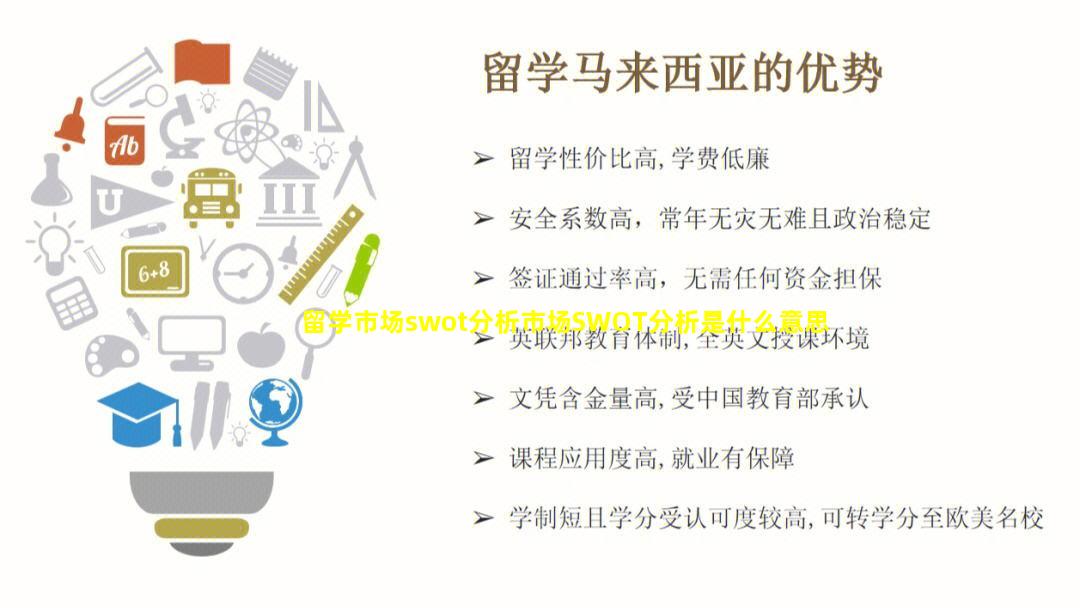 锦泰留学网
锦泰留学网留学市场是一个充满机遇和挑战的市场,通过SWOT分析可以更好地了解其优势、劣势、机会和威胁。
优势(Strengths):
1. 市场需求大:留学需求不断增长,特别是发展中国家的增长潜力巨大。
2. 教育质量高:发达国家的高等教育体系成熟,享有良好的国际声誉。
3. 多样化的课程选择:提供广泛的学科和专业选择,满足不同学生的需求。
4. 移民和就业机会:留学为学生提供了获得高薪工作和移民的机会,吸引了更多的学生。
劣势(Weaknesses):
1. 高昂的费用:留学费用包括学费、生活费以及其他费用,对一些家庭来说是巨大的负担。
2. 文化适应困难:留学生需要适应新的文化、语言和生活环境,有时会面临困难。
3. 竞争激烈:留学市场竞争激烈,需要学生具备优秀的学术成绩和综合素质。
机会(Opportunities):
1. 新兴市场潜力:发展中国家的经济增长和中产阶级的崛起使得留学市场潜力巨大。
2. 数字化转型:随着互联网和科技的发展,留学信息获取变得更加便捷,为市场开拓提供了新机遇。
3. 创新教育模式:结合在线学习、实践项目等创新模式,提供更多灵活、个性化的教育方式。
威胁(Threats):
1. 疫情和移民政策:全球流行疾病、恐怖主义、移民政策等因素对留学市场造成不确定性和威胁。
2. 竞争对手增多:越来越多的国家和大学加大了对国际学生的招揽力度,加剧了市场竞争。
3. 质量和欺诈问题:一些不良的教育机构存在质量和欺诈问题,影响了市场的信誉和可持续发展。
留学市场具有巨大的发展机遇,但也面临着一些挑战和威胁。留学机构和学生需要了解这些因素,并制定相应的战略来应对市场变化,提高服务质量,增强市场竞争力。
市场SWOT分析是指对市场进行分析和评估,通过对市场的内部和外部因素进行分析,找出市场的优势、劣势、机会和威胁。SWOT是Strengths(优势)、Weaknesses(劣势)、Opportunities(机会)和Threats(威胁)的首字母缩写,分别表示市场的优势、劣势、机会和威胁。通过SWOT分析,可以认识到市场的潜在机会和挑战,为制定市场战略和决策提供参考依据。
Strengths:
1. Cost-effective: Second-hand books are often sold at a lower price compared to new books, making them more affordable for customers on a budget.
2. Variety: Second-hand book markets offer a wide range of books from different genres and authors, including out-of-print books that may not be easily available elsewhere.
3. Sustainability: By buying and selling second-hand books, customers contribute to the concept of recycling and reducing waste, thus promoting sustainable practices.
4. Niche market: Second-hand book markets cater to a specific segment of customers who prefer physical copies of books and enjoy the experience of browsing through different titles.
5. Collectibles: Second-hand book markets often host rare and collectible book editions, attracting collectors and enthusiasts.
Weaknesses:
1. Quality concerns: Second-hand books may have wear and tear, annotations, or missing pages, affecting the reading experience.
2. Limited availability: Popular titles and newer releases may be harder to find in second-hand book markets due to lower demand or limited stock.
3. Lack of guarantees: Unlike buying new books, customers may not have a return or refund option in case of dissatisfaction with the purchase.
4. Limited reach: Physical second-hand book markets may have a local or regional presence, limiting access for customers who are not in the immediate vicinity.
5. Competition from digital books: The availability and convenience of e-books and digital platforms provide an alternative to physical books, reducing the potential customer base for second-hand book markets.
Opportunities:
1. Online presence: Establishing an online platform for second-hand book sales can expand the customer reach beyond local markets and provide a convenient option for customers.
2. Partnership with libraries and educational institutions: Collaboration with libraries and educational institutions can create opportunities for acquiring books in bulk and reaching a wider customer base.

3. Events and promotions: Organizing book fairs, discounts, or partnerships with literary festivals can attract more customers and generate buzz around the second-hand book market.
4. Targeting specific customer segments: Focusing on niche markets, such as collectors, students, or specific genres, can help cater to the unique needs and preferences of customers in those segments.
5. Embracing digital formats: Integrating digital formats like e-books or audiobooks into the second-hand book market can attract tech-savvy customers who prefer digital reading options.
Threats:
1. Online book retailers: Large online book retailers offer a wide range of new and used books, potentially overshadowing smaller second-hand book markets.
2. Piracy and unauthorized sharing: The risk of digital piracy or unauthorized sharing of e-books may impact the demand for physical second-hand books.
3. Changing consumer preferences: The shift towards digital reading, audiobooks, or subscription services may diminish the demand for physical second-hand books.
4. Economic factors: Economic downturns or recessions may reduce customer spending on leisure activities, including book purchases.
5. Increased competition: The presence of multiple second-hand book markets or similar businesses in the same area may lead to competition for customers and limited market share.
SWOT分析是一种用于评估一个组织或项目的优势、劣势、机会和威胁的方法。下面是针对露营市场的SWOT分析:
优势:
1. 自然环境优势:露营市场通常位于自然环境优美的地区,如山区、湖泊和海边,吸引了大量喜欢户外活动的人。
2. 健康生活趋势:越来越多的人开始追求健康和活动的生活方式,露营提供了一种身心放松、与自然亲近的方式。
3. 低成本:相比于住在酒店或者租房,露营是一种相对廉价的住宿选择,适合那些注重预算的旅行者。
4. 社交机会:露营可以提供与他人互动和社交的机会,帮助人们建立新的友谊和联系。
5. 多样化的活动:露营提供了多种户外活动,如徒步旅行、钓鱼、皮划艇等,满足了人们对冒险和探索的需求。
劣势:
1. 季节性需求:露营市场通常有明显的季节性需求,夏季是最繁忙的时候,而冬季需求相对较低。
2. 气候不确定性:露营活动容易受到不可预知的天气变化的影响,这可能对人们的旅行计划造成干扰。
3. 市场竞争激烈:随着越来越多的旅行者对露营感兴趣,市场上的露营设施也变得更加多样化和竞争激烈。
4. 基础设施限制:一些露营地可能缺乏基础设施,如卫生间、淋浴和电力,这可能对一些旅行者造成不便。
5. 正式许可要求:一些地区要求露营地持有特定的许可证,这可能增加设置和经营露营地的难度。

机会:
1. 市场增长:随着人们对户外休闲和旅行的需求不断增长,露营市场有望继续扩大。
2. 创新设施:提供创新的设施和服务,如豪华露营帐篷、露天SPA等,可以吸引更多的高端旅行者。
3. 数字化营销:利用互联网和社交媒体,提高露营设施的曝光度,并吸引更多的客户。
4. 与其他行业合作:与户外装备、旅行社等行业合作,提供综合性的服务,增加利润来源。
威胁:
1. 环境保护要求:一些地区对于环境保护有更严格的要求,可能会对露营地的设置和运营带来限制。
2. 经济衰退:经济不景气可能导致人们减少旅行和消费,从而对露营市场造成负面影响。
3. 疫情和自然灾害:突发的疫情和自然灾害可以迅速改变人们的旅行计划,对露营市场造成不可预测的影响。
4. 政策变化:政策变化可能对露营市场的运营和发展带来不利影响,如税收政策的改变或法规的加强。
露营市场具有许多优势和机会,但也面临一些劣势和威胁。为了在竞争激烈的市场中取得成功,露营设施提供商应关注市场需求的变化,提供创新的设施和服务,并与其他相关行业进行合作,以提高竞争力。应密切关注环境保护要求和政策变化,以及灾害和疫情等不确定因素的影响,及时调整经营策略和应对措施。